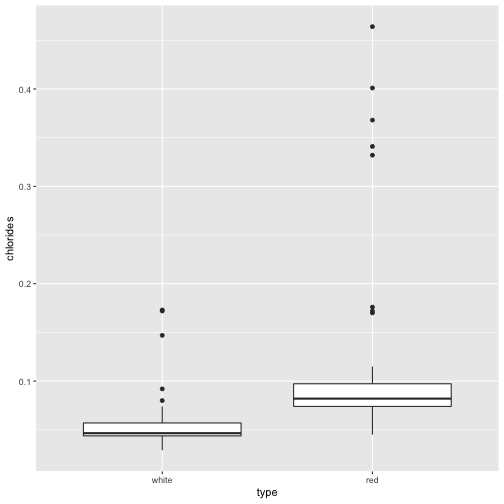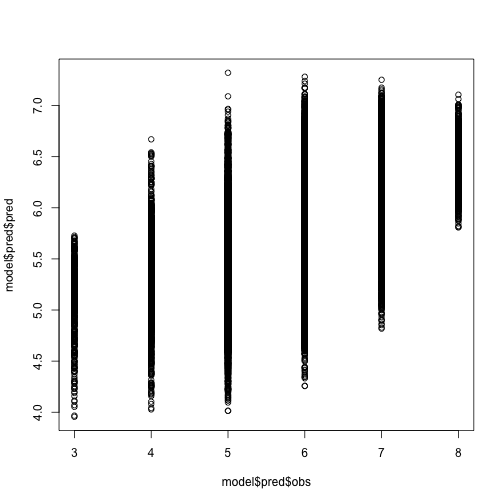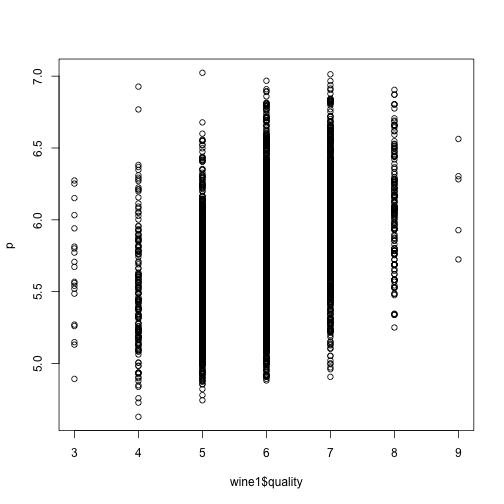Practical Machine Learning For Everyday Life
In this very practical R tutorial, we will see if we can use our machine learning skills to study something we enjoy in everyday life: wine.
We will use wine quality data from the UCI Machine Learning Repository. These two datasets are related to red and white variants of the Portuguese “Vinho Verde” wine. To start, read the data into R.
wine1.url <- "http://archive.ics.uci.edu/ml/machine-learning-databases/wine-quality/winequality-white.csv"
wine1 <- read.csv(wine1.url, header=TRUE, sep=';')
wine2.url <- "http://archive.ics.uci.edu/ml/machine-learning-databases/wine-quality/winequality-red.csv"
wine2 <- read.csv(wine2.url, header=TRUE, sep=';')
We will use only a subset of the data for demonstrative purposes. Each row is a different wine. Columns are features, including physicochemical measurements such as fixed acidity, volatile acidity, citric acid, residual sugar, chlorides, free sulfur dioxide, total sulfur dioxide, density, pH, sulphates, and alcohol, as well as a quality score between 0 and 10 and whether the wine is a red or white.
wine <- rbind(cbind(wine1[1:100,], type='white'), cbind(wine2[1:100,], type='red'))
wine$type <- as.factor(wine$type)
head(wine)
## fixed.acidity volatile.acidity citric.acid residual.sugar chlorides
## 1 7.0 0.27 0.36 20.7 0.045
## 2 6.3 0.30 0.34 1.6 0.049
## 3 8.1 0.28 0.40 6.9 0.050
## 4 7.2 0.23 0.32 8.5 0.058
## 5 7.2 0.23 0.32 8.5 0.058
## 6 8.1 0.28 0.40 6.9 0.050
## free.sulfur.dioxide total.sulfur.dioxide density pH sulphates alcohol
## 1 45 170 1.0010 3.00 0.45 8.8
## 2 14 132 0.9940 3.30 0.49 9.5
## 3 30 97 0.9951 3.26 0.44 10.1
## 4 47 186 0.9956 3.19 0.40 9.9
## 5 47 186 0.9956 3.19 0.40 9.9
## 6 30 97 0.9951 3.26 0.44 10.1
## quality type
## 1 6 white
## 2 6 white
## 3 6 white
## 4 6 white
## 5 6 white
## 6 6 white
Binary classification
First, let’s see if we can train a binary classifier to differentiate between white and red wines. The caret package in R supports a huge number of models.
library(caret)
library(pROC)
head(names(getModelInfo()), n=30)
## [1] "ada" "AdaBag" "AdaBoost.M1" "adaboost"
## [5] "amdai" "ANFIS" "avNNet" "awnb"
## [9] "awtan" "bag" "bagEarth" "bagEarthGCV"
## [13] "bagFDA" "bagFDAGCV" "bam" "bartMachine"
## [17] "bayesglm" "bdk" "binda" "blackboost"
## [21] "blasso" "blassoAveraged" "Boruta" "bridge"
## [25] "brnn" "BstLm" "bstSm" "bstTree"
## [29] "C5.0" "C5.0Cost"
What ever model you choose, make sure it supports the type of modeling you want. We will use a gbm, which supports both classification and regression.
getModelInfo()$gbm$type
## [1] "Regression" "Classification"
First, we will try a binary classification problem. Can we train our gbm classifier to accurately distinguish red and white wines?
trait <- 'type'
features <- wine[, setdiff(colnames(wine), trait)]
head(features)
## fixed.acidity volatile.acidity citric.acid residual.sugar chlorides
## 1 7.0 0.27 0.36 20.7 0.045
## 2 6.3 0.30 0.34 1.6 0.049
## 3 8.1 0.28 0.40 6.9 0.050
## 4 7.2 0.23 0.32 8.5 0.058
## 5 7.2 0.23 0.32 8.5 0.058
## 6 8.1 0.28 0.40 6.9 0.050
## free.sulfur.dioxide total.sulfur.dioxide density pH sulphates alcohol
## 1 45 170 1.0010 3.00 0.45 8.8
## 2 14 132 0.9940 3.30 0.49 9.5
## 3 30 97 0.9951 3.26 0.44 10.1
## 4 47 186 0.9956 3.19 0.40 9.9
## 5 47 186 0.9956 3.19 0.40 9.9
## 6 30 97 0.9951 3.26 0.44 10.1
## quality
## 1 6
## 2 6
## 3 6
## 4 6
## 5 6
## 6 6
class <- wine[, trait]
head(class)
## [1] white white white white white white
## Levels: white red
ctrl <- trainControl(
method="repeatedcv", ## 10 fold cross validation
repeats=5, ## 5 repetitions of cross validation
summaryFunction=twoClassSummary, ## two classes only
classProbs=TRUE,
savePred=TRUE
)
model <- train(
x=features,
y=class,
method="gbm",
trControl=ctrl,
verbose=FALSE
)
Based on the ROC curve, it looks like we did pretty well!
plot.roc(model$pred$obs, model$pred$red)

## double check on new data
predict(model, newdata=wine1[100:110, 1:(ncol(wine1)-1)])
## [1] white white white white white white white white white white white
## Levels: white red
predict(model, newdata=wine2[100:110, 1:(ncol(wine1)-1)])
## [1] red red red red red red red red red red red
## Levels: white red
What features did our classifier find important and useful?
importance <- varImp(model, scale=FALSE)
print(importance)
## gbm variable importance
##
## Overall
## chlorides 81.02693
## volatile.acidity 20.41412
## total.sulfur.dioxide 15.50752
## density 9.51392
## sulphates 5.20135
## free.sulfur.dioxide 4.06884
## residual.sugar 2.94265
## pH 1.73052
## fixed.acidity 0.25914
## citric.acid 0.15809
## alcohol 0.01027
## quality 0.00000
Our gbm classifier found that chlorides was very useful in distinguishing between red and white wines. Indeed, reds seem to have higher chloride levels than whites.
library(ggplot2)
ggplot(data=wine, aes(x=type, y=chlorides)) + geom_boxplot()

Regression
Now, let’s see if we can train a regression model to predict the wine’s quality given its various physicochemical measurements. We will use the red wine data only here since wine type is known to be a confounder for quality in this particular dataset.
trait <- 'quality'
features <- wine2[, setdiff(colnames(wine2), trait)]
head(features)
## fixed.acidity volatile.acidity citric.acid residual.sugar chlorides
## 1 7.4 0.70 0.00 1.9 0.076
## 2 7.8 0.88 0.00 2.6 0.098
## 3 7.8 0.76 0.04 2.3 0.092
## 4 11.2 0.28 0.56 1.9 0.075
## 5 7.4 0.70 0.00 1.9 0.076
## 6 7.4 0.66 0.00 1.8 0.075
## free.sulfur.dioxide total.sulfur.dioxide density pH sulphates alcohol
## 1 11 34 0.9978 3.51 0.56 9.4
## 2 25 67 0.9968 3.20 0.68 9.8
## 3 15 54 0.9970 3.26 0.65 9.8
## 4 17 60 0.9980 3.16 0.58 9.8
## 5 11 34 0.9978 3.51 0.56 9.4
## 6 13 40 0.9978 3.51 0.56 9.4
class <- wine2[, trait]
head(class)
## [1] 5 5 5 6 5 5
ctrl <- trainControl(
method="repeatedcv", ## 10 fold cross validation
repeats=5, ## 5 repetitions of cross validation
savePred=TRUE
)
model <- train(
x=features,
y=class,
method="gbm",
trControl=ctrl,
verbose=FALSE
)
If we plot our predictions against the real quality score, we see a general positive correlation, but definitely less than perfect.
plot(model$pred$obs, model$pred$pred)

## double check by predicting on white wine data
p <- predict(model, newdata=wine1[, setdiff(colnames(wine2), trait)])
plot(wine1$quality, p)

What features did our model find important and useful?
importance <- varImp(model, scale=FALSE)
importance
## gbm variable importance
##
## Overall
## alcohol 727.07
## volatile.acidity 377.59
## sulphates 346.75
## total.sulfur.dioxide 198.10
## pH 125.44
## chlorides 118.79
## citric.acid 113.84
## fixed.acidity 96.45
## density 91.38
## residual.sugar 86.11
## free.sulfur.dioxide 72.66
Alcohol?! Indeed, we see a general correlation between the quality of the wine and its alcohol content. Perhaps unsurprising haha ;)
plot(wine2$quality, wine2$alcohol)

Recent Posts
- Analyzing ICE Detention Data from 2021 to 2025 on 10 July 2025
- Multi-sample Integrative Analysis of Spatial Transcriptomics Data using Sketching and Harmony in Seurat on 22 April 2025
- Using AI to find heterogeneous scientific speakers on 04 November 2024
- The many ways to calculate Moran's I for identifying spatially variable genes in spatial transcriptomics data on 29 August 2024
- Characterizing spatial heterogeneity using spatial bootstrapping with SEraster on 23 July 2024
Related Posts
- Analyzing ICE Detention Data from 2021 to 2025
- Multi-sample Integrative Analysis of Spatial Transcriptomics Data using Sketching and Harmony in Seurat
- Using AI to find heterogeneous scientific speakers
- The many ways to calculate Moran's I for identifying spatially variable genes in spatial transcriptomics data